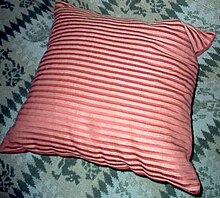
In geometry, the paper bag problem or teabag problem is to calculate the maximum possible inflated volume of an initially flat sealed rectangular bag which has the same shape as a cushion or pillow, made out of two pieces of material which can bend but not stretch.
According to Anthony C. Robin, an approximate formula for the capacity of a sealed expanded bag is:
where w is the width of the bag (the shorter dimension), h is the height (the longer dimension), and V is the maximum volume. The approximation ignores the crimping round the equator of the bag.
A very rough approximation to the capacity of a bag that is open at one edge is:
(This latter formula assumes that the corners at the bottom of the bag are linked by a single edge, and that the base of the bag is not a more complex shape such as a lens).
The square teabag

For the special case where the bag is sealed on all edges and is square with unit sides, h = w = 1, the first formula estimates a volume of roughly
or roughly 0.19. According to Andrew Kepert at the University of Newcastle, Australia, an upper bound for this version of the teabag problem is 0.217+, and he has made a construction that appears to give a volume of 0.2055+.
Robin also found a more complicated formula for the general paper bag, which gives 0.2017, below the bounds given by Kepert (i.e., 0.2055+ ≤ maximum volume ≤ 0.217+).
See also
- Biscornu, a shape formed by attaching two squares in a different way, with the corner of one at the midpoint of the other
- Mylar balloon (geometry)
Notes
- ^ Robin 2004.
References
- Robin, Anthony C (2004). "Paper Bag Problem". Mathematics Today. June. Institute of Mathematics and its Applications: 104–107. ISSN 1361-2042.
- Weisstein, Eric W. "Paper Bag". MathWorld. Archived from the original on 2011-06-29.
External links
- The original statement of the teabag problem
- Andrew Kepert's work on the teabag problem (mirror)
- Curved folds for the teabag problem
- A numerical approach to the teabag problem by Andreas Gammel
- Weisstein, Eric W. "Paper Bag Surface". MathWorld.
| Mathematics of paper folding | |
|---|---|
| Flat folding | |
| Strip folding | |
| 3d structures | |
| Polyhedra | |
| Miscellaneous | |
| Publications | |
| People | |


